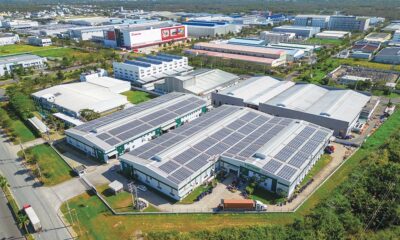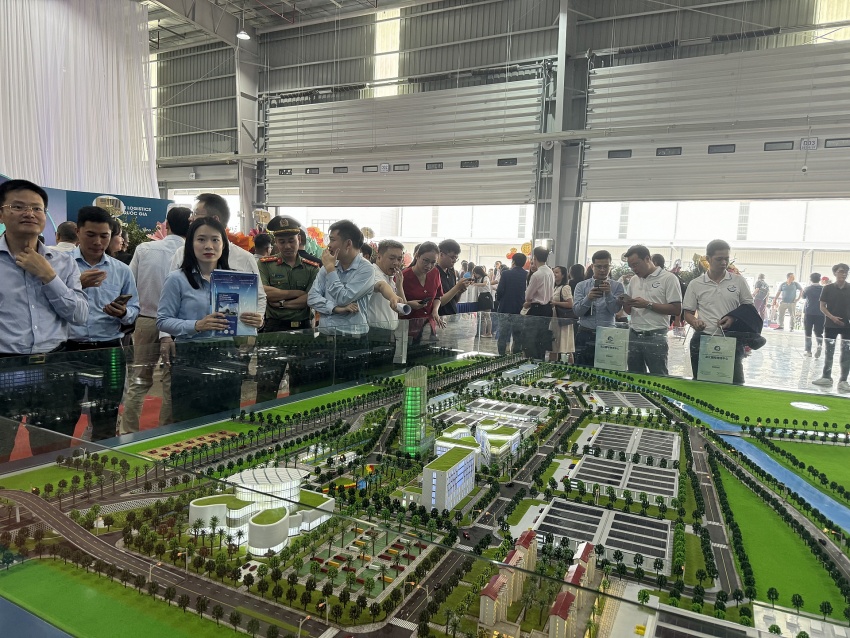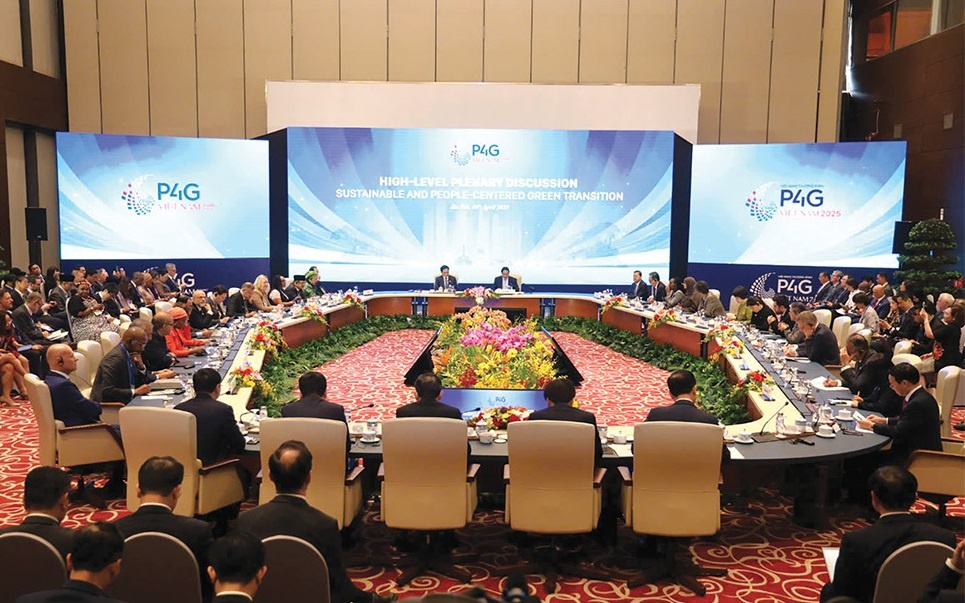Investing
New Vietnam regulations on pharmacy, health insurance, trade union
Published
10 months agoon
Vilaf law firm analyzes Vietnam’s newly amended laws on pharmacy, health insurance, and trade union.

The Amended Law on Pharmacy 2024 clarifies and broadens the scope of foreign invested enterprises’ activities. Photo courtesy of Doanh nghiep & Tiep thi (Enterprises & Marketing).
1. Amended Law on Pharmacy
On November 21, 2024, the National Assembly passed the Law No. 44/2024/QH15 amending and supplementing a number of articles of the Law on Pharmacy 2016 (the Amended Law on Pharmacy 2024).
This new law will take effect from July 1, 2025, except for specific provisions that would take effect from January 1, 2025. Below are key highlights of the Amended Law on Pharmacy 2024.
Introduction of new pharmacy business activities
One of the most critical changes of the Amended Law on Pharmacy 2024 is the official recognition of (i) online sales of drugs and drug materials as a legitimate business activity, and (ii) pharmacy chain as a distinct type of pharmaceutical business.
It is anticipated that these recognition and regulations would solidify the legal framework on emerging business models and present investors in the pharmaceutical sector with new opportunities. It should be noted that:
– Online sales of drugs and drug materials must be conducted through an e-commerce trading platform, e-commerce sales application, or e-commerce website with an online ordering function.
Moreover, the online sale of drugs is only permissible for (i) the retail of over-the-counter drugs not subject to special control and not on the list of drugs restricted from retail sales (except for cases of quarantine for infectious diseases in Group A that have been officially declared under applicable laws on disease prevention and control); and (ii) the wholesale of drugs and drug materials not subject to special control.
Businesses engaging in e-commerce sales of drugs must notify relevant authorities, offerring online consultation on drug use, and ensuring proper delivery to buyers in accordance with laws.
– A pharmacy chain is defined as a system of pharmacies operated by the same entity under a unified quality management system and a single trade name. Each pharmacy within the chain must obtain a separate Certificate of Eligibility for Pharmaceutical Business (CEPB) while the pharmacy chain-organizing entity shall be issued with the CEPB upon meeting legal requirements, including having at least two pharmacies in the chain with their own CEPB and having a unified quality management system to apply to pharmacies in the chain.
Moreover, the person responsible for pharmaceutical expertise of the pharmacy chain-organizing entity must have a bachelor’s degree in pharmacy and have at least two years of experience at an appropriate pharmaceutical establishment while the person responsible for pharmaceutical expertise at each pharmacy in the chain must meet conditions for the same position in a drug retail establishment.
Expansion of scope of activities of foreign-invested enterprises (FIEs)
Before the Amended Law on Pharmacy 2024, the rights and obligations of FIEs in the pharmaceutical sector are scattered across regulations like Decree No. 54/2017/ND-CP and Circular No. 34/2013/TT-BCT, which limit FIEs’ scope of activities to (i) importing drugs and drug materials not on the list of drugs prohibited from import, and (ii) distributing those produced in Vietnam by such FIEs.
The Amended Law on Pharmacy 2024 clarifies and broadens the scope of FIE activities, enabling them to engage in various pharmaceutical operations, including production, import/export, drug testing, clinical trials, and bioequivalence studies. For instance:
– FIEs producing drugs and drug materials are now permitted to wholesale drugs and drug materials that they import, produce, contract-manufacture, or transfer technologies in Vietnam to specific purchasers as specified at laws; and
– FIEs importing drugs and drug materials are now permitted to wholesale drugs and drug materials that they import to drug and drug material wholesale establishments.
Simplification of licensing procedures
The Amended Law on Pharmacy 2024 streamlines the licensing procedures regarding Certificate of Drug Free Sale (“giấy đăng ký lưu hành thuốc” in Vietnamese) and Certificate for Drug Material Free Sale (“giấy đăng ký lưu hành nguyên liệu làm thuốc” in Vietnamese) (collectively, the “CFS”) by limiting cases where prior consultation with the Advisory Council is required and simplifying documentation requirements.
In case where the CFS has expired but the Ministry of Health (MoH) has received the valid renewal application, such CFS still remains valid until the MoH issues its final opinion on the renewal application. This new regulation aims to ensure uninterrupted circulation of drugs and drug materials, preventing supply chain disruption.
The Amended Law on Pharmacy 2024 also eliminates requirements for drug information content confirmation.
Price control measures
With an aim to strengthen control over drug price, Article 1.43 of the Amended Law on Pharmacy 2024 introduces several new control measures, including requiring drug producers and importers to (i) notify the MoH of the estimated wholesale prices of prescription drugs before selling the first batch of such drugs, and (ii) re-notify the prices upon changes.
The MoH will then publicly announce the estimated wholesale prices of prescription drugs on its online portal. No pharmaceutical business establishments are permitted to wholesale prescription drugs at a price higher than the announced price. The MoH is empowered to recommend adjustments to the announced estimated wholesale prices in certain circumstances where the MoH finds that, for example, there is a difference between the estimated wholesale price of a drug and the winning bid price of the same drug and such difference exceeds the maximum margin set by the Government. Still, the MoH’s recommendations will not apply if drug producers and importers can justify the price difference.
Further, certain regulations on price management and declaration have been revised to be aligned with the laws and regulations on pricing.
2. Amended Law on Health Insurance
On November 27, 2024, the National Assembly adopted the Law No. 51/2024/QH15 amending and supplementing a number of articles of the Law on Health Insurance 200811 (the Amended Law on Health Insurance 2024).
This law will take effect on July 1, 2025, except for provisions concerning assignment of technical expertise levels in medical examination and treatment, registration of health insurance-covered medical facility, referral of patients between medical facilities, and procedures for health insurance-covered medical care, which will take effect in January 1, 2025. Below are key highlights of the Amended Law on Health Insurance 2024.
Alignment with the Law on Social Insurance 2024
A notable feature of the Amended Law on Health Insurance 2024 is its harmonization with the provisions of the Law on Social Insurance 2024. Updates include changes regarding participants in the health insurance scheme, timelines for contributing to the health insurance fund, calculation basis for contributions when an employee holds contracts with multiple employers, and scenarios involving late or evaded contributions, along with their corresponding penalties. These updates aim to streamline and simplify the process for contributing to various mandatory insurance funds.
For example, under the current Law on Health Insurance 2008, when an employee has contracts with multiple employers, the employer paying the highest monthly salary is required to contribute to the health insurance fund based on that salary.
This conflicts with the laws on social insurance and employment, which mandate that the first employer contribute to social and unemployment insurance funds based on the salary it pays, causing difficulties for both insurance agencies and employers.
In practice, despite the aforementioned provision of the Law on Health Insurance 2008, insurance agencies often require the first employer to contribute to the health insurance fund, even when it does not pay the highest salary. Article 1.11 of the Amended Law on Health Insurance 2024 resolves this issue by assigning the responsibility for health insurance contributions to the employer responsible for social insurance contributions.
Expansion of health insurance coverage
The Amended Law on Health Insurance 2024 extends health insurance coverage to more medical services. Notably, Article 1.18 of the Amended Law on Health Insurance 2024 includes treatments for strabismus and refractive errors for individuals under 18 years old, expanding coverage from the current limitation for those under 6 years old.
Additionally, the Amended Law on Health Insurance 2024 improves insurance coverage for patients seeking care outside their registered facilities and without complying with regulations on referral of patients between medical facilities. Key improvements include:
– Full coverage within the entitlement limits for emergency treatments at any medical facility nationwide;
– Full coverage within the entitlement limits for treatments of rare diseases, serious illnesses, or advanced surgical procedures at any medical facility with basic or intensive expertise;
– Full coverage within the entitlement limits for treatments at any medical facility with primary expertise; and
– Full coverage within the entitlement limits for inpatient treatments at any medical facility with basic expertise.
Under the current regime, patients are only entitled to full coverage for treatments at district-level medical facilities.
Reallocation of the health insurance fund
According to Article 1.27 of the Amended Law on Health Insurance 2024, the proportion allocated to medical services has been increased from 90% to 92%, while the contingency reserve has been reduced from 10% to 8%. This change ensures that a larger share of the health insurance funds is directed towards patient care, reflecting the government’s focus on improving access and quality of healthcare services.
Digital transformation
Currently, health insurance cards are available in paper formats only. Patients must present their health insurance cards at medical facilities to access health insurance benefits. This creates issues when patients lose or forget their cards, leading to denial of coverage even though they have fully paid health insurance premiums.
The Amended Law on Health Insurance 2024 addresses this problem by introducing electronic health insurance cards. Each participant in health insurance scheme will be assigned a unique insurance code and issued with a health insurance card bearing this insurance code in both electronic and paper formats, both holding equal legal validity. Patients will no longer need to present physical health insurance cards; instead, they can simply provide their health insurance information to medical facilities to access health insurance benefits.
3. New Law on Trade Union
On November 27, 2024, the National Assembly passed the Law on Trade Union No. 50/2024/QH15 (the Law on Trade Union 2024), which will replace the Law on Trade Union 2012 from its effective date of July 1, 2025.
The newly passed law introduces new key guidance to strengthen employee rights while enhancing the role of the Vietnam Trade Union. Key changes are discussed in more detail below.
Expansion of trade union membership
One of the most notable changes is the extension of the right to establish, join, and operate trade unions to Vietnamese workers without formal labor relations. This means that individuals who work as freelancers can now form or become members of trade unions, providing them with a platform to voice their concerns and protect their interests.
In addition, foreign employees working under an employment contract with a term of 12 months or more are now eligible to join grassroots-level trade unions (“công đoàn cơ sở” in Vietnamese). Under the current Law on Trade Union 2012, trade union membership is exclusively available for Vietnamese employees. This change ensures that foreign employees will have representation in trade unions and can benefit from the support and protection offered by trade unions while working in Vietnam.
Integration of employee organizations
According to Article 6 of the Law on Trade Union 2024, existing employee organizations at enterprises (“tổ chức của người lao động tại doanh nghiệp” in Vietnamese) now have the option to apply for integration into the Vietnam Trade Union system. Upon integration into the Vietnam Trade Union, the operations of the existing employee organizations at enterprises shall automatically cease. Members of employee organizations at enterprises who are willing and eligible to join the Vietnam Trade Union according to the Charter of the Vietnam Trade Union will be recognized as trade union members.
Trade union finance
The Law on Trade Union 2024 maintains the trade union fee contribution rate of employers at 2% of the salary fund used as the basis for compulsory social insurance contributions for employees.
Following the application of the ad-hoc policy on exemption from and reduction in trade union fee contribution during Covid-19 pandemic, the Law on Trade Union 2024 now officially recognizes circumstances in which employers can be exempted from or entitled to a reduction or postponement of such fee. In specific, an employer may be considered for:
– an exemption from paying trade union fees when it is in the process of dissolution/ bankruptcy;
– a reduction in the trade union fee contribution rate when it is facing difficulties due to economic reasons or force majeure events; and
– a postponement of paying trade union fees of up to 12 months when it is forced to suspend its operation. Upon the expiry of the postponement period, such employer is obligated to compensate for the unpaid amount during that period.
Prohibited acts
Article 10 of the Law on Trade Union 2024 introduces a number of new prohibited acts in trade union actives, including: (i) failing to ensure conditions for trade union activities; (ii) mismanaging and/or failing to pay trade union fees; (iii) illegally receiving aid or sponsorship; (iv) abusing trade union rights to violate relevant laws; and (v) spreading false information about trade union organization and operation.
Further, to align with the provisions of the Labor Code 2019, Article 10 of the Law on Trade Union 2024 elaborate acts of discriminating against employees and trade union officers for the reason that they establish, join, and operate trade unions to include the following acts, notably: (i) forcing employees to join/ refuse to join the trade union as a condition of employment; (ii) terminating employment relationship or refusing to extend labor contracts to create difficulties for union involvements; (iii) discriminating in wages, benefits and/or working conditions (including financial and non-financial rights and obligations); (iv) spreading false information to defame trade union officers; (v) promising and providing material, non-material benefits to prevent employees from joining trade unions; and (vi) causing difficulties related to work in order to weaken trade union activities.
You may like
-


Vietnam’s Exclusive Economic Zone boasts over 1,000 GW of wind power potential: report
-


Uncertainty weighing on real estate
-


Central Vietnam city seeks $1.84 bln for 15 projects in economic zone
-


Green engagement rides high in Vietnam
-


New standards being reached within green industrial parks
-


Vietnam PM asks Warburg Pincus to invest ‘further and faster’
Investing
Bac Giang International Logistics Centre launched
Published
8 months agoon
April 27, 2025Bac Giang International Logistics Centre was launched on April 22 with an investment of $168 million, and is expected to become a crucial link in the global supply chain.
 |
| Bac Giang International Logistics Centre launch |
Being invested by CNCTech Group, Dolphin Sea Air Services Corporation and Thien An Investment JSC, the logistics centre is located on National Highway 1A, which boasts first-class warehouse supply to meet the growing demand in the northern Vietnamese market.
Its strategic position within the golden economic triangle of Hanoi – Haiphong – Quang Ninh provides convenient connectivity to industrial zones and key logistics centres via national highways No.1A and No.37.
The centre is designed to meet growing demand for logistics infrastructure from businesses in Bac Giang and neighbouring provinces, positioning the area as a new node in northern Vietnam’s logistics network.
The project is a strategic product as a key component of the logistics spearhead in CNCTech Group’s industrial and logistics infrastructure ecosystem. It has been approved by the prime minister as a national level-II logistics centre, covering a planned area of 67 hectares.
At the launch ceremony, Chairman of Bac Giang People’s Committee Nguyen Viet Oanh said, “In recent years, the province’s socioeconomic development has made remarkable strides. Transportation, urban, industrial, and social infrastructure have been synchronously invested in and have yielded high efficiency. However, the province’s logistics service sector has not yet matched its potential, advantages, and socioeconomic development level. The logistics system remains fragmented, transportation costs are high, and trade delivery times are prolonged.”
Recognising this bottleneck, the local authorities have focused on directing the robust development of the logistics system, incorporating it into the provincial plan. This includes developing eight comprehensive logistics centres covering nearly 500ha, three inland container depots, and 33 inland waterway ports.
“Bac Giang, with its strategic location between Hanoi and border provinces, has long been known as a dynamic industrial hub. The remarkable development of the province’s industrial parks has created a solid foundation for the establishment of Bac Giang International Logistics Centre. This centre is not only located on vital transportation routes such as Hanoi-Lang Son Expressway but also directly connects to major border gates, optimising the transport of goods from Bac Giang to the world,” said Oanh.
 |
| A model of the logistics centre |
The project is not merely a warehousing facility, but also a symbol of the integration of modern infrastructure and advanced technology. The centre includes multifunctional warehouse areas, customs-controlled warehouses, non-tariff warehouses, and automated warehouses, meeting the needs of various industries. Notably, it integrates end-to-end logistics solutions, supporting businesses in optimising transportation costs and enhancing production efficiency.
With a long-term vision, the centre aims not only to optimise domestic supply chains but also to become a key connection point in the global logistics network.
Nguyen Van Hung, chairman of the Board of Members of CNC Tech Group, shared, “The establishment of this centre is a strategic step in developing Vietnam’s logistics infrastructure. We are committed to long-term and robust investment in this sector, as logistics is not just infrastructure but an indispensable part of enhancing the competitiveness of Vietnamese businesses on the international stage.”
Vietnam has taken strong action to promote green development among businesses, amid the country facing challenges in finance and technology.
Vietnamese Party General Secretary To Lam told the fourth Summit of the Partnering for Green Growth and the Global Goals 2030 (P4G), organised last week in Hanoi, that Vietnam is focused on strategic breakthroughs to prepare for a national development process that is fast, inclusive, and sustainable.
 |
| The summit in Hanoi covered areas from finance and banking to agriculture and technology Photo: Dung Minh |
“We will strongly transform political commitments into practical actions, creating motivation for businesses and the whole society to participate in sustainable economic development, in which green institutions are the decisive foundation,” General Secretary Lam stressed at a hall attended by government leaders, UN representatives, diplomats, experts, and entrepreneurs.
General Secretary Lam also stressed that when it comes to green transformation, despite being a developing country with a transitional economy and limited resources, Vietnam has achieved some important results.
Besides making a 2050 net-zero commitment in 2021, Vietnam also endorsed six global initiatives at the time, on forest and land use, methane, clean power transition, sustainable food and agriculture, and more.
“Vietnam is now a leading country in supplying renewable energy in ASEAN, with wind and solar power capacity accounting for two-thirds of ASEAN’s total capacity,” he said.
“Additionally, Vietnam is also a good example of encouraging sustainable agriculture. The initiative to develop one million hectares of high-quality and low-emission specialised rice is a pioneering model that many partners and international organisations are interested in.”
A greener future
Vietnam is an active and responsible member of all multilateral mechanisms and major initiatives on green growth and energy transition such as the Paris Agreement on climate change, the Just Energy Transition Partnership, and the P4G.
“However, as a developing country with a transitional economy, we also face many challenges in terms of financial resources, technology, personnel, and resilience to the impacts of climate change and geopolitical fluctuations globally,” said General Secretary Lam.
The summit adopted the Hanoi Declaration, strongly affirming commitments to sustainable growth with people at the centre, and a determination to collaborate responsibly in addressing current global challenges. Vietnam is expected to enjoy continued support from the international community in its journey to a green economy including energy transition.
According to the World Bank, to ensure sufficient funding for responding to climate change, mobilising domestic finance is possible, but external support is needed.
Overall, Vietnam’s total incremental financing needs for the resilient and decarbonising pathways could reach $368 billion over 2022–2040, or approximately 6.8 per cent of GDP per year.
The resilient pathway alone will account for about two-thirds of this amount, as substantial financing will be required to protect the country’s assets and infrastructure as well as vulnerable people.
The cost of the decarbonising pathway will mainly arise from the energy sector – investments in renewables and managing the transition away from coal might cost around $64 billion between 2022 and 2040. All the figures are in net present value terms at a discount rate of 6 per cent.
This $368 billion in financing needs will include $184 billion from private investments or about 3.4 per cent of GDP annually, $130 billion or about 2.4 per cent of GDP annually from the state budget; and $54 billion or about 1 per cent of GDP per year from external sources.
Choi Youngsam, South Korean Ambassador to Vietnam, said that within the P4G framework, South Korea and Vietnam have completed or are currently implementing joint projects in areas such as food and agriculture, energy, water, and urban development.
“Looking ahead, both sides are expected to broaden and deepen their partnership under the P4G framework,” he said.
At the P4G Summit held in Seoul in May 2021, the two governments signed the Framework Agreement on Cooperation in Response to Climate Change, laying a solid policy foundation for the implementation of international emissions reduction ventures.
“On this basis, I hope that South Korea will leverage its technological expertise and financial resources to carry out greenhouse gas emission reduction projects in Vietnam, with both countries mutually recognising the results,” Ambassador Youngsam said.
“This would contribute to establishing a win-win model of emissions reduction cooperation. At the same time, I look forward to seeing active engagement from South Korean enterprises possessing green technologies, in close collaboration with the Vietnamese government.”
Encouraging developments
Deputy Minister of Science and Technology Hoang Minh said at a policy dialogue on the sidelines of the P4G 2025 that the active participation and strong cooperation from stakeholders – from the public and private sectors to international organisations – can help materialise Vietnam’s aspiration of an efficient and sustainable innovative startup ecosystem.
“Innovation, creative entrepreneurship and collaboration are key to solving environmental problems, while encouraging the development of a circular economy,” he said.
Vietnam currently has over 4,000 innovative startups, including two unicorns valued at over $1 billion, 11 companies valued at over $100 million, more than 1,400 startup support organisations, 202 co-working spaces, 208 investment funds, and 35 business promotion organisations. Among these, it is estimated that around 200–300 companies focus on green transition, covering areas such as renewable energy, environmental technology, sustainable agriculture, and the circular economy.
According to the Vietnamese Ministry of Foreign Affairs, hosting the fourth P4G Conference is of great significance to Vietnam. It is aimed to boost its role as a good friend, a reliable partner, and a responsible member of P4G and the international community. Moreover, it is also aimed to reaffirm its commitment to sustainable development, energy transition, and the goal of carbon neutrality by 2050. Besides that, it is aimed at contributing to raising awareness of international cooperation and encouraging the role and voice of developing countries in the sector of green growth and sustainable development.
| Pham Minh Chinh, Prime Minister
For Vietnam, together with digital transformation, we identify green transition as an objective necessity, a key factor, and a breakthrough driving force to promote rapid growth and sustainable development. This aligns with the strategic goal of becoming a developing country with modern industry and upper-middle income by 2030, and a developed, high-income country by 2045, while also contributing to the gradual realisation of Vietnam’s commitment at COP26 to achieve net-zero emissions by 2050. From practical experience with initial positive results, especially in renewable energy, green agricultural development, and participation in multilateral mechanisms and initiatives on green transformation, as the host of the fourth P4G Summit, Vietnam has three suggestions for discussions which pave the way for further cooperation in the coming time. First is to perfect green mindset, with a focus placed on the development of science and technology, innovation, and digital transformation linked to green growth. This includes recognising that green resources stem from green thinking, green growth is driven by green transition, and green resources arises from the green awareness of people and businesses in nations and regions throughout the world. Second is to build a responsible green community, in which, the government plays a guiding role, encouraging, and ensuring a stable and favourable institutional environment for green growth. The private sector functions as a core investor into technological development and the dissemination of green standards. The scientific community take the lead in developing green technologies and training green human resources. Meanwhile, citizens continuously enhance their green awareness, truly becoming beneficiaries of the outcomes of green transformation. Thirdly, it is necessary to promote international cooperation and robust multilateral green cooperation models, particularly public-private partnerships, South-South cooperation, North-South cooperation, and multilateral cooperation frameworks. This is aimed at removing institutional barriers, enhancing access, and speeding up the flow of green capital, green technology, and green governance. Developed countries should take the lead in fulfilling commitments to provide financial, technological, and institutional reform support. Meanwhile, developing countries would need to leverage their internal strengths and effectively utilise external resources. |
Investing
Public-private partnerships a lever for greener innovation
Published
8 months agoon
April 26, 2025Public-private partnerships are no longer a supporting mechanism, but a strategic pillar in the global pursuit of the green transition.
The high-level dialogue between government leaders and businesses at the 2025 P4G Vietnam Summit last week, chaired by Prime Minister Pham Minh Chinh, brought together senior officials, global experts, international organisations, and private sector leaders.
They recognised that the climate crisis, digital transformation, and resource depletion are converging in ways that demand not only innovation, but deep and long-term collaboration between the public and private sectors.
UN Deputy Secretary-General Amina J. Mohammed acknowledged Vietnam’s leadership in renewable energy, noting its potential to attract trillions in sustainable investment.
“Emerging economies must accelerate the adoption of new investment models, particularly those that align private capital with green infrastructure priorities. Governments must work with the private sector to expand ambition, strengthen accountability, and deliver real impact,” she said.
From Italy, Prime Minister’s Climate Envoy Francesco Corvaro stressed that public-private partnerships (PPPs) are indispensable in addressing climate finance gaps. Drawing from Italy’s experience, he underscored the importance of public investment as a risk mitigator, enabling private sector participation in clean energy and smart infrastructure projects.
“Public investment can unlock private capital, but local authorities must lead with clear priorities and long-term vision,” Corvaro noted. “You can’t talk about renewables, AI, or digital infrastructure without modern, resilient grids, and that requires strong public-private alignment.” he said
Alejandro Dorado, Spain’s High Commissioner for Circular Economy, argued that the case for stronger PPPs lies at the intersection of two accelerating forces: the environmental-climate crisis and a wave of disruptive technologies.
“In a world where AI, green technologies, and digitalisation are reshaping the global economy, the clock is ticking. According to the Intergovernmental Panel on Climate Change, we have less than a decade to prevent irreversible climate disaster. Meanwhile, the World Economic Forum has identified biodiversity loss as one of the most severe economic risks,” he said.
 |
Dorado added that while multilateralism is being questioned or weakened in some quarters, the need for cooperation has never been more urgent – both to solve environmental challenges and to harness the transformative potential of innovation.
“No government or business can tackle these crises alone. Public authorities must provide the regulatory frameworks, fiscal incentives, and infrastructure deployment needed at scale to safeguard the common good,” he stressed.
From the business side, Stuart Livesey, country representative of Copenhagen Infrastructure Partners (CIP), provided a frank but optimistic outlook. Livesey stated CIP’s commitment to supporting Vietnam’s transition, but emphasised the need for enabling conditions.
“What we seek are clear, bankable projects underpinned by stable regulatory frameworks, collaborating with strong local partnerships. This is where public-private cooperation becomes not just helpful, but essential,” Livesey noted. “Over the next 10-15 years, the offshore wind sector and green energy consumers will trigger massive demand for new technologies, digital solutions, and skilled labour.”
To meet this demand, CIP is investing not only in infrastructure, but also in capacity building, research and development, and local supply chain development through partnerships with Vietnamese universities.
Still, he acknowledged barriers. “Technological application and innovation in green projects face challenges, from long-term financing constraints and skilled labour shortages to fragmented policy signals. These are not unique to Vietnam, but they require proactive, tailored local solutions,” he said. “Addressing issues such as grid availability, regulatory clarity, and inter-ministerial coordination will be critical.”
Tim Evans, CEO of HSBC Vietnam, stated that the banking sector is ready to facilitate green finance, particularly in sectors aligned with national climate targets.
“We see ourselves as a bridge between global capital and local sustainability goals. The clearer the pipeline of bankable, climate-aligned projects, the faster we can move capital,” he noted. “What’s crucial now is consistency in policy and coordination among stakeholders to ensure these projects reach maturity.”

Bac Giang International Logistics Centre launched

Vietnam’s Exclusive Economic Zone boasts over 1,000 GW of wind power potential: report

Uncertainty weighing on real estate

Central Vietnam city seeks $1.84 bln for 15 projects in economic zone

